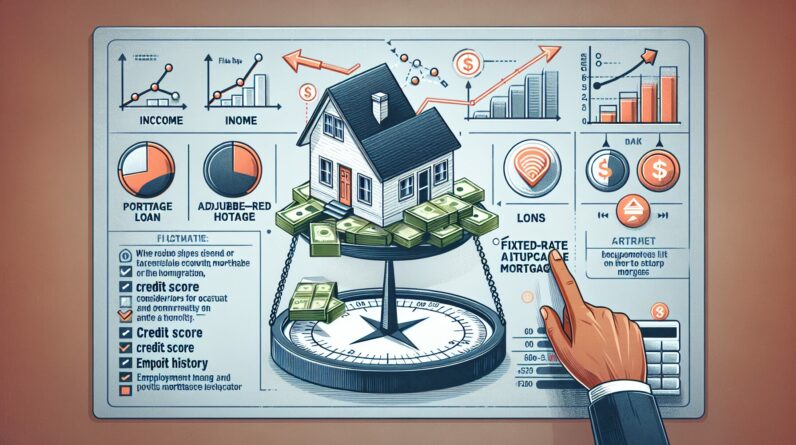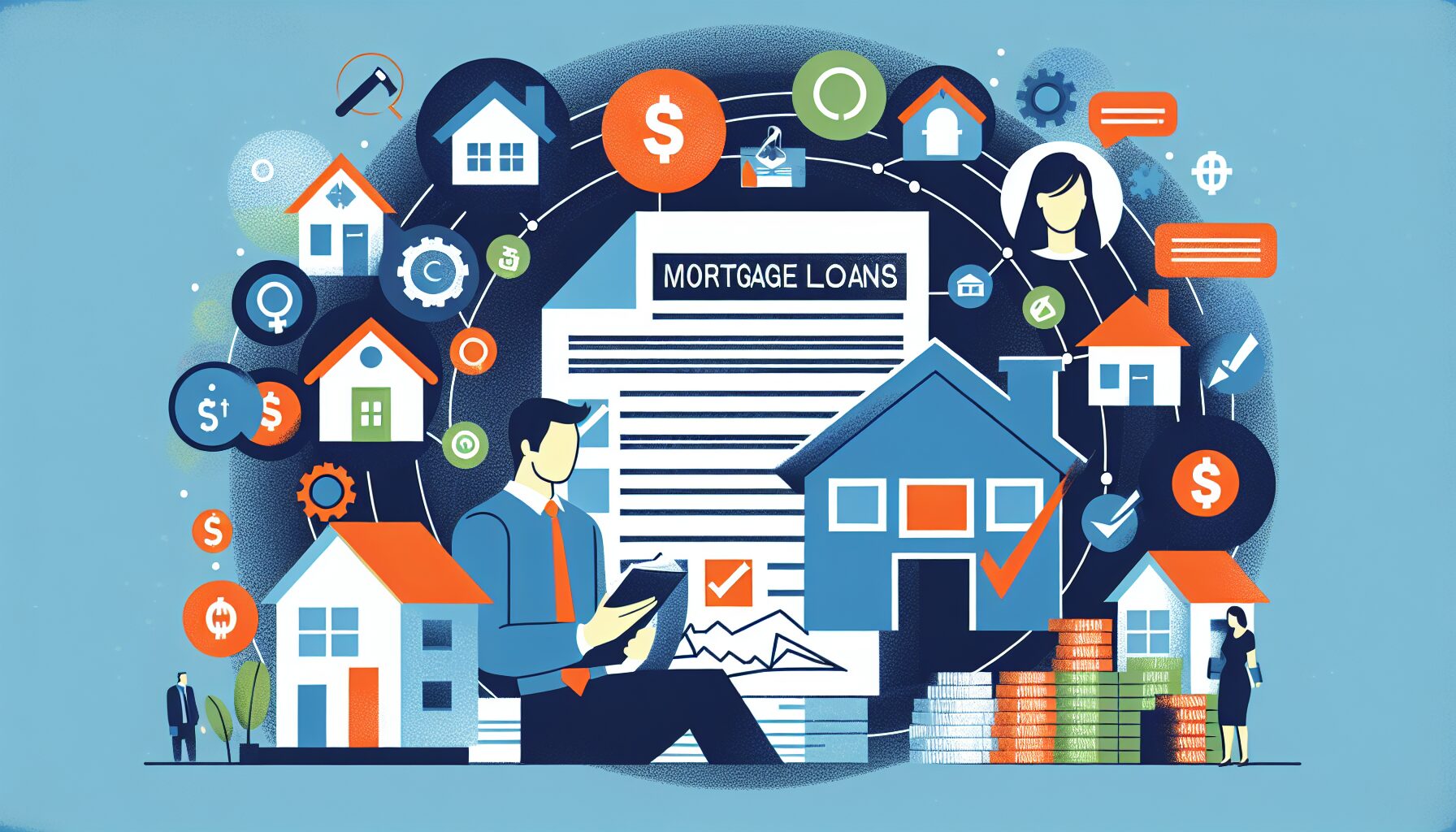
You may have heard the term “mortgage loan” before, but do you actually know what it means? A mortgage loan is a type of loan that is used to finance the purchase of a property. It is a financial agreement between a borrower and a lender, where the borrower receives a certain amount of money to buy a home and agrees to repay that amount over a specific period of time, typically with interest. In this article, we will explore the ins and outs of mortgage loans, what they entail, and how they can impact your financial future.
Table of Contents
Definition of a Mortgage Loan
Basic explanation
A mortgage loan, also known as a mortgage, is a type of loan that allows you to borrow money to purchase a home or other real estate property. It is a financial agreement between you and a lender, typically a bank, where the lender provides the funds needed to buy the property, and you agree to repay the loan over a specified period of time, typically with interest.
Key features
Mortgage loans have several key features that make them different from other types of loans. First, they are secured loans, which means that the property you are purchasing serves as collateral for the loan. This means that if you fail to make your mortgage payments, the lender has the right to take possession of the property through a process called foreclosure.
Second, mortgage loans have specific repayment terms, including the length of the loan term, the interest rate, and the monthly payment amount. These terms are agreed upon between you and the lender at the time of taking out the loan.
Lastly, mortgage loans are typically long-term loans, with loan terms ranging from 15 to 30 years. This allows borrowers to spread the cost of their home purchase over a longer period of time, making it more affordable.
Types of Mortgage Loans
Fixed-Rate Mortgage
One of the most common types of mortgage loans is a fixed-rate mortgage. With a fixed-rate mortgage, the interest rate remains the same throughout the entire term of the loan. This means that your monthly payment amount will also remain constant. Fixed-rate mortgages provide stability and predictability, making them a popular choice for many borrowers.
Adjustable-Rate Mortgage (ARM)
In contrast to a fixed-rate mortgage, an adjustable-rate mortgage (ARM) has an interest rate that can change over time. Typically, the interest rate is fixed for an initial period, such as 5, 7, or 10 years, and then adjusts periodically based on market conditions. As a result, your monthly payment amount can increase or decrease during the life of the loan. ARMs can be beneficial for those who plan to sell or refinance within a few years, but they also carry more uncertainty and potential for higher payments.
Government-Backed Mortgage Loans
Government-backed mortgage loans are loans that are insured or guaranteed by a government agency, such as the Federal Housing Administration (FHA), the Department of Veterans Affairs (VA), or the United States Department of Agriculture (USDA). These loans are designed to make homeownership more accessible for low-income or first-time homebuyers who may have difficulty qualifying for conventional loans.
Interest-Only Mortgage
Interest-only mortgages allow borrowers to pay only the interest on the loan for a specified period, typically 5 to 10 years. After the interest-only period ends, the borrower must begin making payments toward both the principal and interest, resulting in higher monthly payments. Interest-only mortgages can be helpful for those who expect their income to increase in the future, but they can also be risky if the borrower is unable to afford the higher payments.
Balloon Mortgage
A balloon mortgage is a short-term loan with fixed monthly payments for a specific period, often 5 to 7 years. At the end of the term, the remaining balance of the loan is due in a lump sum payment. Balloon mortgages can be advantageous for those who plan to sell or refinance their home before the balloon payment is due, but they can also carry the risk of not being able to afford the lump sum payment.
Reverse Mortgage
Reverse mortgages are loans available to homeowners who are 62 years or older and have significant equity in their homes. With a reverse mortgage, the lender makes payments to the borrower, either in a lump sum, a line of credit, or monthly payments. The loan is repaid when the borrower sells the home, moves out of the home, or passes away. Reverse mortgages can provide additional income for retirees, but it’s important to understand the potential long-term costs and implications.
Jumbo Mortgage
Jumbo mortgages are loans that exceed the conforming loan limit set by Freddie Mac and Fannie Mae, which is generally $548,250 as of 2021. These loans are used to finance high-value properties, such as luxury homes or properties in expensive real estate markets. Jumbo mortgages often have stricter qualification requirements and higher interest rates compared to conventional mortgages.
Bridge Loans
Bridge loans are short-term loans that help bridge the gap between the purchase of a new home and the sale of an existing home. They can be useful when a borrower wants to buy a new home before selling their current one. Bridge loans have higher interest rates and fees, as they are meant to be temporary financing solutions.
Construction Loans
Construction loans are used when you plan to build a new home or make significant improvements to an existing property. These loans provide funding for the construction process and can be converted into a traditional mortgage once the construction is complete. Construction loans typically have higher interest rates and require detailed plans and specifications.
Second Mortgages
A second mortgage is a loan taken out in addition to an existing mortgage. It allows homeowners to tap into their home equity by borrowing against the value of their property. Second mortgages can be used for various purposes, such as home improvements, debt consolidation, or funding education expenses. However, they come with the risk of foreclosure if you are unable to make the required payments on both your first and second mortgages.

Requirements for Obtaining a Mortgage Loan
Credit Score
Your credit score is an important factor in obtaining a mortgage loan. It is a numeric representation of your creditworthiness and is based on your credit history, including your payment history, the amount of debt you owe, the length of your credit history, and the types of credit you have. Lenders use your credit score to assess the risk of lending to you and determine the interest rate and terms of your loan. Generally, a higher credit score will result in better loan terms and a lower interest rate.
Income and Employment Verification
Lenders require proof of income and verification of employment to determine your ability to repay the mortgage loan. This typically involves providing pay stubs, W-2 forms, or tax returns. Self-employed borrowers may need to provide additional documentation, such as profit and loss statements or business bank statements. Lenders look at your income stability and the ratio of your monthly debt payments to your income.
Down Payment
A down payment is a percentage of the purchase price that you must pay upfront when buying a home. It is a way to demonstrate your financial commitment and reduce the lender’s risk. The amount required for a down payment can vary depending on the type of mortgage loan and other factors. Conventional loans typically require a down payment of 3% to 20% of the purchase price, while government-backed loans may require a lower down payment, sometimes as low as 0% for eligible borrowers.
Debt-to-Income Ratio
Your debt-to-income (DTI) ratio is a comparison of your monthly debt payments to your gross monthly income. Lenders use this ratio to assess your ability to manage additional debt and make mortgage payments. A lower DTI ratio indicates that you have more income available to cover your mortgage payment. Generally, lenders prefer a DTI ratio of 43% or lower, although some loans may allow for higher ratios with compensating factors.
Property Appraisal
Before approving a mortgage loan, lenders typically require a professional appraisal of the property you wish to buy. This is to ensure that the property’s value supports the loan amount and to mitigate the lender’s risk. The appraiser evaluates various factors, such as the property’s condition, location, and comparable sales in the area. If the appraised value is significantly lower than the loan amount, the lender may require a larger down payment or deny the loan altogether.
Mortgage Insurance
Mortgage insurance is often required when the down payment is less than 20% of the purchase price. This insurance protects the lender in case the borrower defaults on the loan. There are two types of mortgage insurance: private mortgage insurance (PMI) for conventional loans and mortgage insurance premiums (MIP) for government-backed loans. The cost of mortgage insurance varies depending on the loan amount, loan-to-value ratio, and other factors.
Documentation
To obtain a mortgage loan, you will need to provide various documentation, including identification documents, income verification, employment history, bank statements, and tax returns. It is important to gather all the necessary documents prior to applying for a loan to streamline the application process.
Residential Status
Lenders generally require borrowers to have legal residency or citizenship in the country where the property is located. Non-resident borrowers may face additional requirements, such as a larger down payment or higher credit score. It is important to consult with the lender or a mortgage professional if you have a non-traditional residential status.
How Does a Mortgage Loan Work?
Application and Pre-Approval
The mortgage loan process begins with the application stage. You will need to complete a loan application, providing personal and financial information, as well as details about the property you wish to purchase. The lender will review your application and evaluate your eligibility for a mortgage loan.
If you meet the initial criteria, you may receive a pre-approval letter, which indicates the maximum loan amount you qualify for based on your financial information. This pre-approval letter can strengthen your position as a buyer and demonstrate your seriousness to sellers.
Loan Processing
Once you have a ratified purchase agreement, the loan enters the processing stage. During this time, the lender will request additional documentation and verify the information provided in your application. They may also order an appraisal, review your credit history, and conduct other checks. The processing stage helps the lender evaluate your financial stability and assess the risk associated with lending to you.
Loan Approval and Closing
If the lender is satisfied with your financial information and the property appraisal, they will issue a loan approval. At this stage, you will receive a loan estimate that outlines the terms of the loan, including the interest rate, closing costs, and any other fees. You will also receive a closing disclosure, which provides a detailed breakdown of the final costs.
Prior to closing, you will have the opportunity to review and sign all necessary loan documents. This includes the mortgage note, which outlines the terms of the loan, and the deed of trust or mortgage, which provides the lender with a security interest in the property. The closing process also involves paying any required fees and signing various legal documents.
Repayment Terms
Once the loan is closed, the repayment terms of the mortgage loan come into effect. This includes the amount of the monthly mortgage payment, the interest rate, and the loan term. It is important to understand these terms and obligations, as they will have a significant impact on your financial stability and homeownership experience.
Interest and Principal
Every mortgage payment consists of two main components: interest and principal. The interest is the cost of borrowing the money, expressed as a percentage of the loan amount. The principal is the remaining balance of the loan that you are repaying. Initially, a larger portion of your monthly payment goes towards interest, while a smaller portion goes towards the principal. Over time, as you make payments, the proportion of the payment applied to the principal increases.
Amortization
Mortgage loans are typically structured as amortizing loans, which means that they are paid off gradually over time through regular monthly payments. The payment amount is calculated using an amortization schedule, which shows the breakdown of each payment into interest and principal. As you make payments over the loan term, the balance decreases until the loan is fully repaid.
Escrow Accounts
Some mortgage loans may require the establishment of an escrow account. An escrow account is a separate account held by a third party, such as a title company, that is used to collect and disburse funds for property-related expenses, such as property taxes and homeowner’s insurance. Each month, a portion of your mortgage payment is deposited into the escrow account, ensuring that these necessary expenses are paid on time.
Loan Servicing
Once the loan is closed, the lender may choose to keep the loan in its own servicing portfolio or sell it to another institution. Loan servicing involves collecting your monthly mortgage payments, maintaining the loan records, and handling any customer service inquiries related to the loan. It is important to understand who will be servicing your loan and how to contact them if you have any questions or concerns.

Benefits of Mortgage Loans
Home Ownership
One of the primary benefits of a mortgage loan is the opportunity to become a homeowner. A mortgage loan allows you to purchase a property that you can call your own, providing stability and the ability to customize your living space to your liking. Homeownership offers a sense of pride and can be a stepping stone to financial security.
Tax Deductions
Another advantage of mortgage loans is the potential for tax deductions. In many countries, including the United States, mortgage interest and property tax payments can be deducted from your income when filing your tax return. These deductions can help reduce your taxable income and lower your overall tax burden.
Equity Building
As you make mortgage payments, you are building equity in your property. Equity is the difference between the market value of your property and the remaining balance on your mortgage loan. Over time, as you continue to make payments and the value of your property appreciates, your equity increases. This equity can be used in the future for various purposes, such as borrowing against your home or funding other financial goals.
Predictable Payments
With a fixed-rate mortgage, your monthly payment amount remains the same throughout the entire loan term. This provides stability and predictability, as you know exactly how much you need to budget for your mortgage payment each month. This can help you plan and manage your finances effectively.
Leverage and Investment Opportunities
Owning a property and having a mortgage loan can provide opportunities for leveraging your investment and creating wealth. As the value of your property appreciates over time, you may be able to borrow against your home’s equity, known as a home equity loan or line of credit. This can be used for various purposes, such as home improvements, education expenses, or starting a new business. By strategically using your home equity, you can potentially create additional wealth and financial opportunities.
Drawbacks of Mortgage Loans
Interest Payments
One of the main drawbacks of mortgage loans is the cost of interest payments. Over the life of the loan, you will end up paying a significant amount of interest, especially with longer-term loans. This can increase the overall cost of homeownership and reduce the amount of money you can allocate toward other financial goals.
Potential Foreclosure
When you take out a mortgage loan, your home serves as collateral for the loan. If you are unable to make your mortgage payments, the lender has the right to foreclose on your property, potentially leading to eviction and the loss of your home. It is crucial to carefully consider your ability to afford your mortgage payment before committing to a loan.
Risk of Negative Equity
In certain market conditions, the value of your property may decrease, resulting in negative equity. Negative equity occurs when the outstanding balance of your mortgage loan is higher than the market value of your property. This can limit your options if you need to sell your home or refinance. It is important to consider the potential risk of negative equity when purchasing a property.
Restrictive Debt Obligations
Committing to a mortgage loan means taking on a significant debt obligation. This debt may limit your ability to allocate funds toward other financial goals, such as saving for retirement, paying off other debts, or pursuing other investments. It is important to carefully consider the impact of a mortgage loan on your overall financial situation and long-term goals.

Factors Affecting Mortgage Loan Terms
Current Market Conditions
Mortgage loan terms can be influenced by current market conditions, including interest rates, housing market trends, and economic factors. When interest rates are low, it may be a good time to secure a mortgage loan with a favorable rate. However, in a rising interest rate environment, your borrowing costs may increase.
Creditworthiness
Your creditworthiness, as reflected in your credit score and credit history, plays a significant role in determining the terms of your mortgage loan. A higher credit score generally results in more favorable loan terms and a lower interest rate. Lenders look at your creditworthiness to assess the risk of lending to you and determine your ability to repay the loan.
Loan-to-Value Ratio
The loan-to-value (LTV) ratio compares the loan amount to the appraised value of the property. A lower LTV ratio indicates a lower risk for the lender, as there is a greater equity cushion in the property. Higher LTV ratios may result in higher interest rates or require mortgage insurance.
Loan Size
The size of the loan can affect the terms of your mortgage loan. Jumbo loans, which exceed the conforming loan limits set by Freddie Mac and Fannie Mae, often have stricter qualification requirements and higher interest rates compared to smaller loan amounts.
Length of Loan Term
The length of the loan term can have a significant impact on your monthly payment and the overall cost of the loan. Shorter-term loans, such as 15-year mortgages, generally have higher monthly payments but allow you to pay off the loan faster and save on interest. Longer-term loans, such as 30-year mortgages, have lower monthly payments but result in more interest paid over the life of the loan.
Type of Property
The type of property you are purchasing can also affect the terms of your mortgage loan. Residential properties are typically considered less risky than commercial properties, which can result in more favorable loan terms. Properties in certain locations or with unique features may also impact the loan terms.
Mortgage Loan Process
Exploring Loan Options
The first step in the mortgage loan process is to evaluate your loan options. This involves researching different types of mortgage loans, understanding the eligibility requirements, and comparing interest rates and terms from different lenders. You can utilize online resources, consult with a mortgage professional, or visit financial institutions to gather information and determine the loan options that best suit your needs.
Application and Documentation
Once you have identified a potential lender and loan option, you will need to complete a loan application. This process involves providing personal and financial information, including details about your income, assets, debts, and the property you wish to purchase. You will also need to submit documentation to support the information provided in your application. This may include pay stubs, bank statements, tax returns, and identification documents.
Pre-Approval
After reviewing your application and documentation, the lender may provide you with a pre-approval. This is an estimate of the loan amount you qualify for based on your financial information. The pre-approval letter can strengthen your position as a buyer and demonstrate your seriousness to sellers. It is important to note that a pre-approval is not a guarantee of final loan approval, as additional verification and underwriting are still required.
Loan Underwriting
Once you have a ratified purchase agreement, the lender will begin the underwriting process. This involves a thorough review of your financial information, credit history, and the details of the property. The lender may order an appraisal to determine the market value of the property, as well as review any additional documents or information that may be required. The underwriting process helps assess the risk associated with lending to you and verify that you meet the lender’s requirements.
Closing and Funding
If the underwriting process is successful and the loan is approved, you will proceed to the closing stage. At closing, you will review and sign all necessary loan documents, pay any required fees, and provide proof of insurance. The lender will then disburse the funds to the seller, and you will become the legal owner of the property.
Loan Servicing
After the loan is closed, the lender may choose to keep the loan in its own servicing portfolio or sell it to another institution. Loan servicing involves collecting your monthly mortgage payments, maintaining loan records, and managing any customer service inquiries related to the loan. It is important to understand the loan servicer and how to contact them if you have any questions or need assistance.

Risks and Considerations
High Debt Burden
Taking on a mortgage loan means committing to a significant debt obligation. It is important to carefully consider your ability to afford the mortgage payment, taking into account your income, expenses, and other financial commitments. A high debt burden can strain your finances and limit your ability to save for other goals or handle unexpected expenses.
Fluctuating Interest Rates
For adjustable-rate mortgages (ARMs) or mortgage loans with variable interest rates, the interest rate can change over time. Fluctuating interest rates can result in changes to your monthly payment amount and may increase your borrowing costs. It is important to understand the terms of your mortgage loan and how changes in interest rates can impact your finances.
Possible Financial Hardship
Unforeseen events, such as job loss, illness, or other financial setbacks, can create financial hardship and make it difficult to meet your mortgage payment obligations. It is important to have an emergency fund and a plan to manage unexpected expenses to help mitigate these risks. Additionally, exploring loan options with flexible repayment terms or income-based programs may provide some relief during times of financial hardship.
Prepayment Penalty
Some mortgage loans may include a prepayment penalty, which is a fee charged if you pay off the loan early or make additional principal payments above a certain threshold. Prepayment penalties can limit your flexibility to refinance the loan or pay it off early. It is important to review the terms of your loan and understand any potential prepayment penalties before committing to a mortgage.
Default and Foreclosure
Failing to make your mortgage payments on time can lead to default and, ultimately, foreclosure. Default occurs when you fail to meet the terms of the loan agreement, such as making timely payments. Foreclosure is the legal process where the lender takes possession of the property to recover the outstanding debt. Defaulting on a mortgage loan can have long-term consequences, including damage to your credit score and the loss of your home. It is crucial to carefully consider your financial situation and ability to meet your mortgage payment obligations before taking on a mortgage loan.
Conclusion
A mortgage loan is a powerful financial tool that allows you to purchase a home or real estate property. It provides the opportunity for home ownership, wealth-building, and financial stability. However, it is important to approach the mortgage loan process carefully and consider the potential risks and responsibilities that come with it. By understanding the various types of mortgage loans, the requirements for obtaining a mortgage loan, and the factors that can affect the terms of the loan, you can make informed decisions and navigate the mortgage loan process with confidence. Ultimately, a mortgage loan can be a valuable tool in achieving your homeownership and financial goals.








